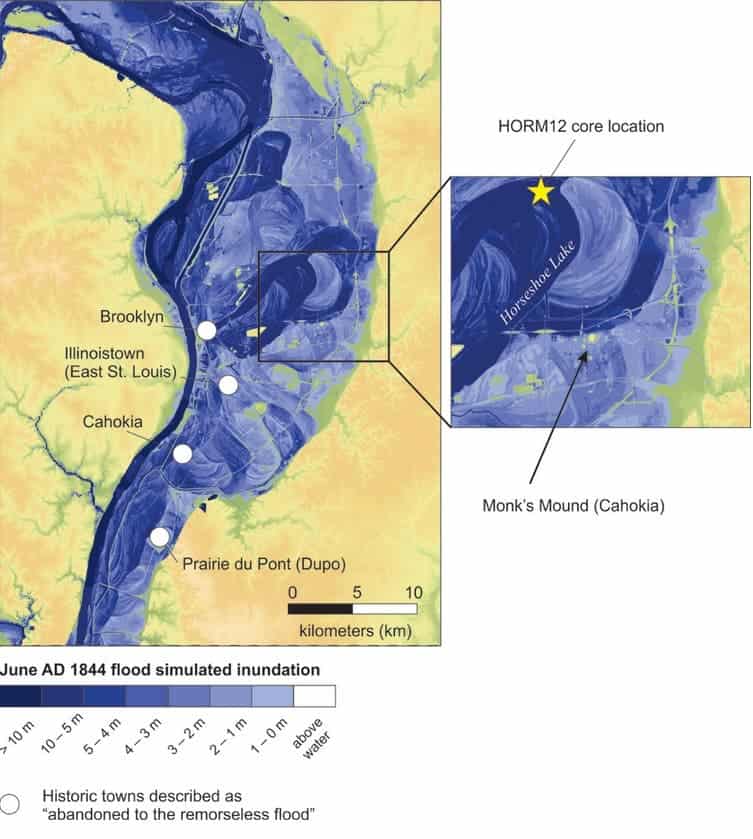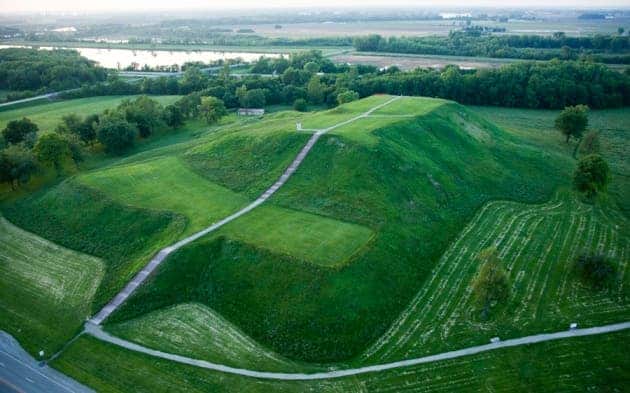Megafloods likely wiped out one of the most significant American civilizations, a new study has concluded. Until now, the reason of their demise remained a mystery.

The Cahokias were a pretty big deal in the 1100s. Their civilization featured dashing plazas, a complex social structure, and developed cultural practices. They had a huge economic power, dominating the area from the Great Lakes to the Gulf of Mexico, and at their peak, their main city hosted tens of thousands of people. But its population started to decline quickly in 1200, and by 1350, its former glory was forgotten, and it was mostly a ghost town. So what happened?
Publishing their findings in the Proceedings for the National Academy of Sciences, a team of researchers extracted sediment cores up to 5.5 metres in length from the Horseshoe Lake, representing 2,000 years of deposition. They immediately noticed that something was off – a series of light band fine sediments popped up, something the team dubbed “lake butter” because of their unusually fine and silky texture.
“We had these really strange layers in the core that didn’t have any pollen and they had a really odd texture,” Munoz says. “In fact, one of the students working with us called it ‘lake butter.'”
Samuel Munoz, a geographer at the University of Wisconsin–Madison, and his colleagues dated buttery bands using radiocarbon techniques, and they concluded that they represent periods of massive flooding along the Mississippi River.
“We call the river the ‘Big Muddy’ for a reason,” he adds. “This sediment is essentially the sediment that makes the water muddy and brown.”
To validate the findings, the team also collected sediments from Grassy Lake, roughly 120 miles downstream from Cahoki – they found the same traces. Sissel Schroeder, a professor of anthropology accompanied the researchers to help provide historical and archaeological context for the findings. She said that the geology and radiocarbon dating is consistent with the archaeological finds.

“We see some important changes in the archaeology of the site at this time, including a wooden wall that is built around the central precinct of Cahokia,” she said. “There are shifts in craft production, house size and shape, and other signals in material production that indicate political, social and economic changes that may be associated with social unrest.”
However, this doesn’t necessarily mean that the floods caused the demise of the Cahokias – it’s just a temporal fit, but there’s no indication of causality. Munoz said:
“Can we say that this flood at 1200 caused the abandonment of Cahokia? No. We can’t say that with any certainty,” he adds. “All we can show is that there is a correspondence in time.”
Larry Benson, adjunct curator of anthropology at the University of Colorado Boulder’s Natural History Museum has published several papers in which he argued that drought was responsible for their downfall – but it may actually be a combination of the two, adding more stress on the civilization’s agriculture.
“We are not arguing against the role of drought in Cahokia’s decline, but this presents another piece of information,” says Munoz.
“It also provides new information about the flood history of the Mississippi River, which may be useful to agencies and townships interested in reducing the exposure of current landowners and townships to flood risk,” says Williams, a professor of geography and director of the Nelson Institute for Environmental Studies Center for Climatic Research.
All in all, this seems to be an important piece of the puzzle – maybe even the decisive one.
“We hope archaeologists can start integrating these flood records into their ideas of what happened at Cahokia and check for evidence of flooding,” says Munoz, who plans to continue studying flood records in lakes around the country once he graduates this year.
Journal Reference: Samuel E. Munoza, Kristine E. Gruley, Ashtin Massie, David A. Fike, Sissel Schroeder, and John W. Williams. Cahokia’s emergence and decline coincided with shifts of flood frequency on the Mississippi River. doi: 10.1073/pnas.1501904112


